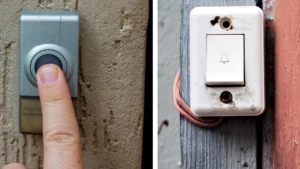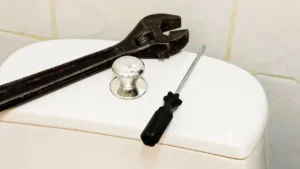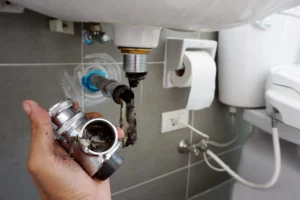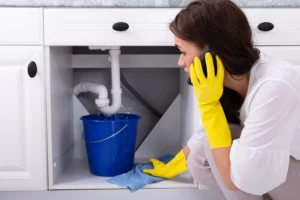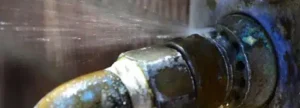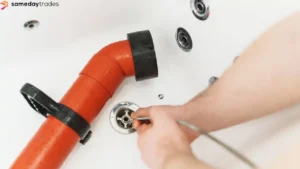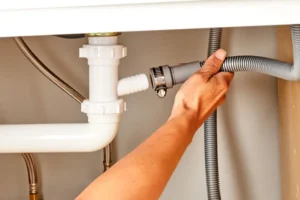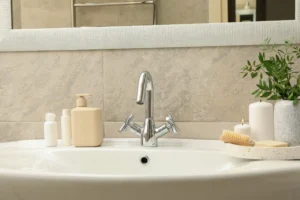A clogged drain can drive anyone up the wall. It’s often caused by things like grease, hair, or soap building up over time. This blog post will share simple fixes and long-term solutions for better drain cleaning.
Common Causes of Drain Clogs
Drains don’t just clog themselves, so something’s sneaking in. From everyday habits to forgotten objects, there’s plenty that can block the flow.
Accumulated grease and food particles
Grease and food scraps clog sinks fast. Pouring cooking oil or fat down your kitchen sink creates sticky build-up in pipes. Over time, this grease traps small food particles, forming stubborn blockages.
Left uncleaned, it may even lead to foul sewer gases escaping into your home.
Avoid rinsing large food pieces and greasy pans directly into the drain. Use a grease trap or wipe plates with paper towels first. Regular maintenance, like flushing hot water and mild drain cleaners weekly, can reduce this risk.
Prevention is cheaper than repairs!
Hair and soap scum buildup
Hair tangles with soap scum to create stubborn clogs. This often happens in bathroom sinks, shower drains, and toilets. Over time, the mix forms a sticky mess that traps more debris like dirt or even small objects.
Wet hair easily slips into drains during showers or while using the sink.
Using drain strainers can stop most of it before it causes trouble. Regular deep cleaning helps prevent buildup too—try once a month for best results. Tools like drain snakes or plungers are great for clearing minor clogs caused by hair and scum.
For tougher blockages, you might need stronger options like chemical cleaners or calling a plumber!
Foreign objects and debris
Toys, jewellery, or small plastic items often find their way into drains accidentally. These objects block water flow and cause clogs in kitchen sinks and bathrooms. A drain strainer can catch these before they vanish down the pipes.
In homes with kids, coins or even bits of paper might end up jammed inside the plumbing. Routine inspections help spot such problems early. Ignoring them could lead to costly repairs or full pipe replacements later on.
Effective DIY Drain Cleaning Solutions
Got a blocked drain? You don’t always need fancy tools or harsh chemicals—simple fixes can work wonders.
Baking soda and vinegar method
Pour one cup of bicarbonate of soda down the clogged drain. Microwave one cup of vinegar for a few seconds to warm it, then pour it over the bicarbonate of soda. The fizzing reaction helps break down buildup like grease, food particles, or soap scum.
Let this sit for about 30 minutes.
Flush the drain with hot water after the wait. This combination is an easy and eco-friendly drain opener that tackles blockages without harsh chemicals like caustic cleaners. Use this method monthly to prevent clogs and keep your pipes clear!
Using a drain snake or plunger
A drain snake can grab or push clogs out of the pipe. It works best for stubborn blockages like hair or foreign objects. Feed it slowly into the drain, turning the handle to break up or hook onto debris.
Pull it back carefully to avoid splatter. A bit messy? Yes, but worth it.
Plungers use suction to dislodge minor clogs in sinks or toilets. Create a tight seal over the drain and push down forcefully several times. The trapped air pressure moves stuck particles along, clearing smaller buildups quickly.
No fancy tools needed—just elbow grease!
Professional Drain Cleaning Options
Sometimes, tackling stubborn clogs needs a pro’s touch. They bring heavy-duty tools that can clear even the nastiest blockages for good.
Hydro jetting
High-pressure water jets blast through stubborn clogs. Hydro jetting clears grease, tree roots, and debris from pipes. This method uses water at pressures up to 4,000 PSI. It’s powerful enough to scrub pipe walls clean without causing damage.
Only trained professionals handle this equipment due to its strength. A blocked drain filled with years of buildup stands no chance against hydro jetting. It’s a safe, non-chemical option for keeping your plumbing in top shape!
Mechanical augers
Mechanical augers are powerful tools for breaking down tough clogs. These devices, often referred to as drain augers, have a rotating cable that cuts through stubborn blockages like grease or tree roots.
They work best on severe clogs deep in your pipes where DIY methods fall short.
Professionals usually operate them to avoid pipe damage. Their ability to clear intense blockages makes them ideal for persistent drainage issues. While they offer ease of use under skilled hands, they’re not meant for regular upkeep but shine in serious situations needing quick action.
Choosing Between Different Types of Chemical Drain Cleaners
Chemical drain cleaners come in three main types: caustic, oxidising, and acidic. Caustic cleaners use substances like lye or caustic potash. They work by generating heat to dissolve grease and food clogs in kitchen sinks.
Oxidising cleaners rely on chemicals such as bleach or nitrate compounds to break down organic material. These are best for stubborn hair clogs in bathroom drains. Acid-based products, which often contain sulphuric acid, are powerful but can damage pipes if overused.
Drano is a popular example of chemical cleaners you may find at most stores.
Always read the labels before using any cleaner, especially around children or pets—it’s no joke that these products can be harmful if handled poorly. Avoid mixing them with other cleaning supplies like ammonia; this could release dangerous gases into your home! For copper or old metal pipes often found in older houses (like those seen on hgtv.com), it’s safer to stick with mild options to prevent corrosion over time.
Cream of tartar mixed with baking soda might even suffice for lighter blockages without risking pipe damage!
Preventative Measures to Avoid Future Clogs
Stop clogs before they start by making simple changes that keep your drains flowing freely—your future self will thank you!
Regular drain maintenance
Clean drains monthly to prevent clogged drains. Focus on kitchen, bathroom, and laundry sinks. Grease, food particles, hair, and soap scum often build up fast. Natural cleaning solutions work best for routine care.
A mix of baking soda and vinegar is a great option.
Proactive care saves money on repairs later. Installing drain strainers helps catch debris before it causes trouble. Wash strainers regularly to keep them effective. Small steps like these can make housekeeping much easier over time!
Installing drain strainers
Pop a drain strainer into your sink or shower. It stops hair, food bits, and debris before they slip down the pipes. This reduces clogs and keeps water flowing freely.
They are easy to use and cheap, often costing less than $10. By catching buildup early, you’ll need fewer cleaning products or calls to plumbers later on.
Long-Term Fixes for Persistent Clogging Issues
Sometimes, fixing bad pipes or upgrading outdated plumbing is the only way to stop clogs for good.
Pipe replacement
Old pipes wear out over time. They can crack, rust, or become blocked. Replacing them stops recurring clogs and prevents major damage later. Aged plumbing often struggles with modern water pressure and waste levels.
Newer systems handle demands better.
A professional plumber must assess your pipes first. This ensures the best solution for your home’s needs. Pipe replacement may seem costly upfront but saves you from endless repairs down the track!
Upgrading to modern plumbing systems
Modern plumbing systems reduce clogging. They use smoother pipes to stop debris from sticking. Older pipes, like cast iron, rust and catch waste over time. PVC or copper pipes last longer and flow better.
These upgrades fix hidden problems.
Professional installation is key for these systems. Experts handle the process quickly and safely. While it may cost more upfront, it prevents future clogs and costly repairs.
Conclusion
A clogged drain doesn’t have to ruin your day. Understanding the causes, like hair or grease buildup, is key. Use simple fixes like baking soda and vinegar or invest in professional help for tougher blockages.
Prevent future problems by keeping up with regular cleaning and adding strainers to catch debris. With a bit of effort now, you can keep your drains flowing smoothly for good!
FAQs
Why does my drain keep getting clogged?
Your drain might clog because of hair, grease, food scraps, soap build-up, or even small objects falling in. Over time, these blockages worsen and stop water from flowing properly.
How can I fix a clogged drain permanently?
To fix it for good, clear the blockage completely and prevent future clogs by using strainers, avoiding pouring grease down the sink, and cleaning drains regularly.
Are there long-term solutions to avoid constant clogs?
Yes! Regular maintenance is key. Check your pipes often, use natural cleaners like vinegar and baking soda monthly to break down debris, and never flush items that don’t belong.
Should I call a professional if my drain keeps clogging?
If DIY fixes fail or the problem keeps coming back even after clearing it yourself—yes! A plumber can inspect deeper issues like pipe damage or unseen obstructions causing repeated trouble.
Why does my drain keep getting clogged?
Your drain might clog because of hair, grease, food scraps, soap build-up, or even small objects falling in. Over time, these blockages worsen and stop water from flowing properly.
How can I fix a clogged drain permanently?
To fix it for good, clear the blockage completely and prevent future clogs by using strainers, avoiding pouring grease down the sink, and cleaning drains regularly.
Are there long-term solutions to avoid constant clogs?
Yes! Regular maintenance is key. Check your pipes often, use natural cleaners like vinegar and baking soda monthly to break down debris, and never flush items that don’t belong.
Should I call a professional if my drain keeps clogging?
If DIY fixes fail or the problem keeps coming back even after clearing it yourself—yes! A plumber can inspect deeper issues like pipe damage or unseen obstructions causing repeated trouble.


